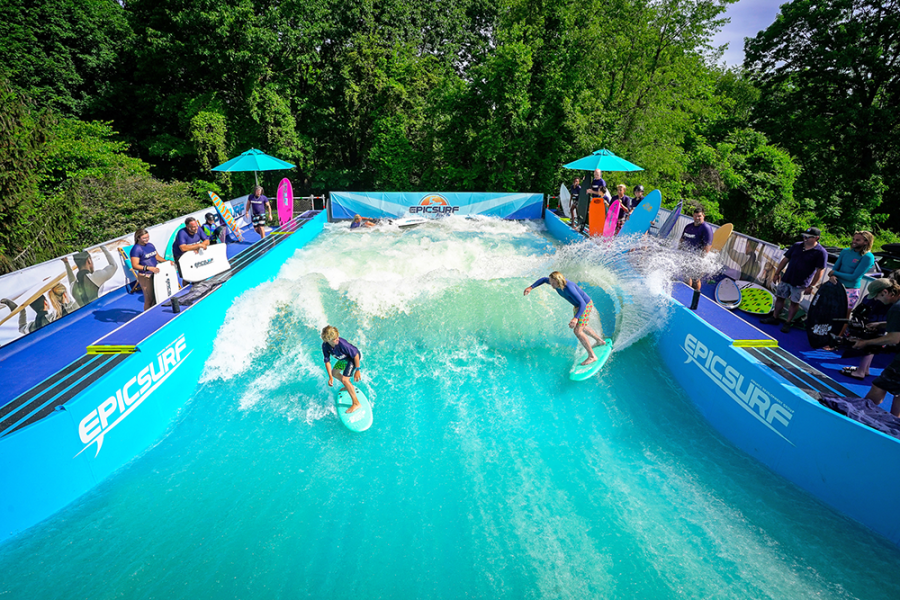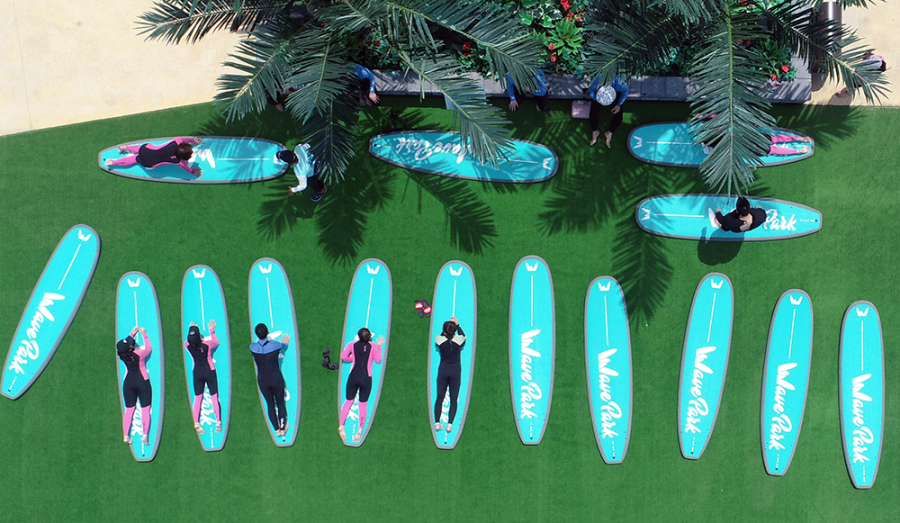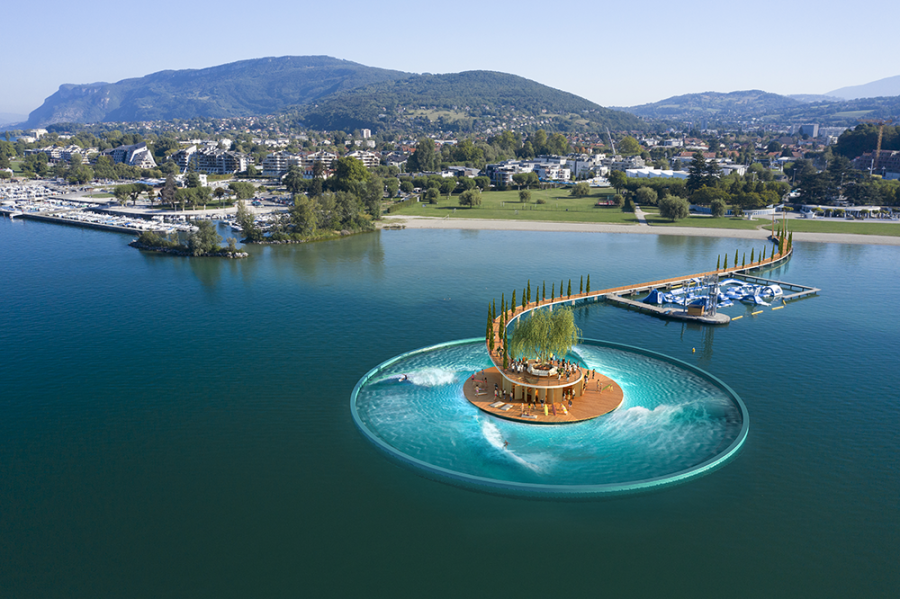Rolling into the Future
When surfing made its debut at the Tokyo 2020 Olympic Games this summer, millions of viewers around the world tuned in to watch 40 Olympians from 18 countries glide across the ocean’s surface, showing off their tricks and skills. A monumental moment for the sport, surfing’s inclusion in the Olympics not only highlighted its continued global growth and popularity but also introduced it to new audiences.
While surfing can be limited to coastal areas, innovations in wave technology and surf attractions present more and more opportunities for participants of all ages and levels to join the sport of 40 million surfers without being close to a beach, dealing with the changeable nature of ocean waves, or competing with other surfers to catch the best one.
“In the ocean, waves can sometimes be unpredictable, and then you also have currents and an environment where there are a lot of surfers out, and you’re not quite sure how you fit in or what the etiquette rules are,” says Damon Tudor, CEO of Urbnsurf, which operates a surf park in Tullamarine, Melbourne, Australia, and is set to open Urbnsurf Sydney in 2022. “The difference with the Urbnsurf lagoon is that because you are in a con-trolled environment, you’re creating specific sessions tailored for certain skill levels. We define an expert session like a 2-meter-high barreling wave, and cruiser level is a smaller wave for people who are just learning.”
Tudor says he’s seen rapid advances in wave technology in the last five years, including the use of a touch-screen panel to designate a session’s wave type, wave frequency, and gaps between sets at Urbnsurf, powered by Wavegarden, a Spanish engineering company specializing in wave-generating systems and surfing lagoons.
“For me, what’s evolved the fastest has been the quality and frequency of the wave,” he says. “In some of the older technology, you often had to wait maybe a minute or two between waves. Now, there’s a wave every eight to 16 seconds, so it’s much more like the beach.”

EpicSurf’s Nonstop Wave
With a portfolio of more than 500 wave pools and wave systems implemented around the world, Aquatic Development Group (ADG) has been at the forefront of wave technology, having developed, tested, and manufactured recreational wave pools and rivers, stationary waves, deep-water waves, and surf pools, as well as specialty wave systems for aquariums, rescue training, and movies, such as 2012’s adventure drama “Life of Pi.” In June 2021, ADG launched its newest product, EpicSurf, offering experienced surfers a true deep wave of water to practice and show off their skills and beginners the chance to get on a surfboard for the first time outside of an intimidating ocean environment.
“ADG has been in the business of making waves and equipment for over 50 years under our WaveTek brand,” says Jessica Mahoney, ADG’s director of marketing. “EpicSurf came about after looking at the surf industry and what we could do in it, bringing our wave-making experience to the table. We wanted to have a ride where people could really surf and use real surfboards in a deep-water standing wave.”
After months of research and development, the ADG team started building EpicSurf at its headquarters in Cohoes, New York, United States, in September 2020 and began trial runs in December—through rain, snow, and cold weather. Surfers from around the country traveled to ADG’s facility to test EpicSurf, including professional surfer Ben Gravy and professional skimboarder Blair Conklin.
“They were integral in our development process, as we wanted feedback from professional surfers to make sure the wave really delivered an authentic experience,” Mahoney says. “To be able to build EpicSurf here and see it firsthand really gives us an understanding and knowledge of what the rider dynamic is like and how we can improve the experience. ADG is the first to manufacture this type of ride in North America.”
EpicSurf creates a continuous wave that can be adjusted from 3 feet to 5 feet to suit a variety of skill levels. To help novice surfers wade into the EpicSurf experience, a training bar is available for support to steady their balance and inch their way out into the open water when they’re ready.
“Something that we’re going to see more and more of over the next decade is that surfing is going to become more holistic and accessible with the advent of these man-made surf pools and parks,” Mahoney says. “When you bring in a product like EpicSurf, you’ve brought the surf culture to a place that never would have had it. You can use EpicSurf for learning, enhancing your skills, having fun, getting together, and then you can transfer some of that to the ocean.”

Building a Micro-Surf Park
The EpicSurf can be an ideal addition for resorts looking to differentiate with a unique amenity, as well as for creating a stand-alone micro-surf park, Mahoney says.
“The culture you can build around the sport of surfing, the interaction and staying power of the wave itself—not to mention the tremendous op-portunity with food and beverage and retail among both riders and spectators—makes the EpicSurf an ideal attraction to build a branded venue around,” she says.
One example of a micro-surf park currently under consideration is CitySurf, a new venue in development by John and Trisha Hoss of Bombora Global. The 6,500-square-foot CitySurf-branded building in Seattle would house the EpicSurf, a 1,000-square-foot observation deck area, locker rooms, and retail.
As foodies, John and Trisha Hoss are focused on producing a dining component to add to the guest experience, so they partnered with Jason Stoneburner, a Seattle-based chef who also surfs, to manage a 2,500-square-foot restaurant at the facility.
“Part of our original concept was to give people a place to just unplug, have a good meal, hang out with their kids, and watch them surf—do something that’s healthy and active that will make them feel good and want to come back,” says Trisha Hoss.
The Hosses hope to expand their micro-surf park to Denver, Colorado, and Portland, Oregon, as year-round attractions.

Cultivating a Surf Audience
Surfing culture is growing in South Korea, and with the opening of Wave Park, one of the world’s largest surf parks, in October 2020, interest in the sport is set to gain traction, says Kim Hyunseok of Daewon Plus Group and Wave Park in Siheung, Gyeonggi province, South Korea.
“Surf parks are spreading fast throughout the world, and Wave Park is in a leading position to contribute to this trend,” Kim says. “Korea has a few natural surfing spots located primarily along the east coast of the peninsula or Jeju Island. However, the launching of Wave Park now adds a new surf destination in the west coast of Korea. It is a very realistic surf destination for surfers living in the area of Seoul.”
Located on a new 167,000-square-meter waterfront development on Turtle Island, Wave Park came together through Daewon Plus Group’s collaboration with Wavegarden to use Wavegarden Cove technology capable of generating waves every eight seconds and offering more than 20 different wave types, ranging from knee-high beginner waves to steep barrels.
“Wave Park is perfectly suited for surfers of two different levels because it is partitioned with a left branch of 160 meters and right branch of 200 meters; this extended bay area gives more space for beginners to enjoy the waves,” Kim says. “The park can accommodate up to 8,000 surfers at a time with amenities and facilities, including restaurants, retailers, professional surf instruction, and areas for observation and relaxation.”
Daewon Plus Group is planning a second Wave Park in South Korea, with a vision of increasing tourism.

Developments on the Horizon
Crafting a unique surfing destination around its own wave technology is at the center of Okahina Wave’s mission.
“We operate Okahina Spots in a complete ecosystem around the wave technology, working with partners from the food and beverage industry, public and private tourism sectors, governmental authorities, and different areas that are complementary together,” says Sébastien Mounier, associate director and chief financial officer for Okahina Wave, headquartered in Bordeaux, France.
Mounier describes the company’s new wave technology as the “second generation of artificial waves,” looking to improve the biodiversity of degraded aquatic environments through its sustainable surf destinations on existing bodies of water.
“We tried to think differently to find a way to make artificial waves without building pools or using concrete,” says Laurent Hequily, founder and CEO of Okahina Wave and Waveriding Solution. “We manufacture floating atolls that look like a plate that is floating upside down just below the surface of the water. Generators create circular waves around the floating atoll, so we can set it up in any bodies of water like lakes, seas, or urban water bodies.”
Okahina Wave is a removable structure with a low-energy consumption operation that doesn’t require a water filtration system. The floating atolls come in three sizes ranging from 40 to 110 meters in diameter that generate different wave heights, from 80 centimeters to 2 meters. Features can adjust wave shape, height, power, and thickness for beginner to expert surfers. Okahina Wave received the Solar Impulse Efficient Solution Label, which assesses the economic profitability of products or processes that protect the environment.
“The positive effects come from the fact that we move a large quantity of water and oxygenate it to fight eutrophication, a major problem for many bodies of water in the world,” Hequily says. “It’s going to improve the habitats of the flora and fauna in those degraded environments.”
Okahina Wave has four installations in the pipeline in France. The first full-scale Okahina facility is set to launch in summer 2022 in partnership with local authorities of the Vienne department, next to Futuroscope. Libourne/Saint-Émilion, France, will become an Okahina Spot by the end of 2023, and Okahina is collaborating with Aix-Les-Bains City to install and operate a medium Okahina Wave in Bourget Lake, France’s largest lake, around 2023-2024.
Okahina is also working with the local authorities of the Île-de-France region to install and operate a large Okahina Wave in Vaires-Torcy, an official site of the Paris 2024 Olympic Games.
“We wanted to have a ride where people could really surf and use real surfboards in a deep-water standing wave.”
— Jessica Mahoney, Aquatic Development Group
“Wave Park is perfectly suited for surfers of two different levels...”
— Kim Hyunseok, Wave Park
“We operate Okahina Spots in a complete
ecosystem around the wave technology …”
— Sébastien Mounier, Okahina Wave
-
Juanita Chavarro Arias is the managing editor of Funworld.
